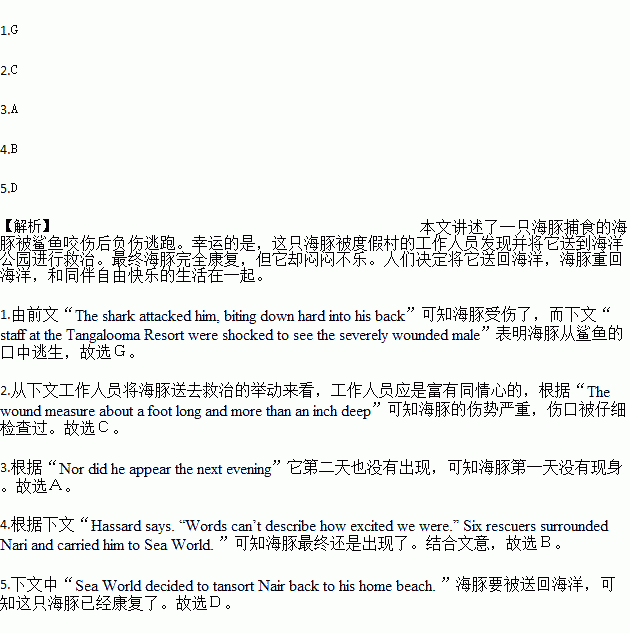题目内容
The young dolphin swam in the waters off Brisbane, Australia, and found his seafood dinner. Suddenly he realized that he was not the only hungry predator(捕食者)in the area. A ten-foot tiger shark aimed at the same fish. The dolphin refused to give up the meal and dashed to the shark. The shark attacked him, biting down hard into his back. 1.
Later, on the sandy beach nearby, staff at the Tangalooma Resort were shocked to see the severely wounded male. He was a regular visitor, a playful 12-year-old dolphin called Nari. “We’ve known him all his life, since he was a baby,” says resort director Trevor Hassard. 2.The wound measure about a foot long and more than an inch deep. He took photos of Nari and sent them to vets at Sea World, a local marine mammal park. They agreed that Nari needed emergency care.
The next day, Sea World staff traveled to the beach to catch Nari.3.Nor did he appear the next evening. Everyone was depressed and worried about him.
4.“I had started thinking the worst,” Hassard says. “Words can’t describe how excited we were.” Six rescuers surrounded Nari and carried him to Sea World. The vets performed an operation to remove the dead flesh from around the bite. Nari was then moved to a special pool where his wound was cleaned and treated regularly.
5.Sea World decided to tansort Nair back to his home beach. Hassard had worried that the other dolphins might reject Nari after such a long absence. That concern disappeared when Nari’s friend Echo instantly recognized him and moved close to his side.
A. But Nari didn’t show up
B. Three days later, Nari finally turned up.
C. He felt quite worried when he took a close look at Nari’s injury
D. After seven weeks, Nari was fully recovered but growing restless.
E. Shark researchers are trying to warn people to escape without being eaten
F. The five-meter-long dolphin simply swam away, disappearing into the water below.
G. Luckily, the wounded dolphin managed to escape from the shark’s biting with violent struggle.
| A. | suppose | B. | increase | C. | course | D. | loose |
Sinek's unlikely success as both an inspirational speaker and a bestselling author isn't just dumb luck.It's the result of fears faced and erased,trial and error and tireless practice,on and off stage.Here are his secrets for delivering speeches that inspire,inform and entertain.
Don't talk right away.
Sinek says you should never talk as you walk out on stage."A lot of people start talking right away,and it's out of nerves,"Sinek says."That communicates a little bit of insecurity and fear."
Instead,quietly walk out on stage.Then take a deep breath,find your place,wait a few seconds and begin."I know it sounds long and tedious and it feels excruciatingly awkward when you do it,"Sinek says,"but it shows the audience you're totally confident and in charge of the situation."
Show up to give,not to take.
Often people give presentations to sell products or ideas,to get people to follow them on social media,buy their books or even just to like them.Sinek calls these kinds of speakers"takers,"and he says audiences can see through these people right away.And,when they do,they disengage.
"We are highly social animals,"says Sinek."Even at a distance on stage,we can tell if you're a giver or a taker,and people are more likely to trust a giver-a speaker that gives them value,that teaches them something new,that inspires them-than a taker."
Speak unusually slowly.
When you get nervous,it's not just your heart beat that quickens.Your words also tend to speed up.Luckily Sinek says audiences are more patient and forgiving than we know.
"They want you to succeed up there,but the more you rush,the more you turn them off,"he says."If you just go quiet for a moment and take a long,deep breath,they'll wait for you.It's kind of amazing."
Turn nervousness into excitement.
Sinek learned this trick from watching the Olympics.A few years ago he noticed that reporters interviewing Olympic athletes before and after competing were all asking the same question."Were you nervous?"And all of the athletes gave the same answer:"No,I was excited."These competitors were taking the body's signs of nervousness-clammy hands,pounding heart and tense nerves-and reinterpreting them as side effects of excitement and exhilaration.
When you're up on stage you will likely go through the same thing.That's when Sinek says you should say to yourself out loud,"I'm not nervous,I'm excited!"
Say thank you when you're done.
Applause is a gift,and when you receive a gift,it's only right to express how grateful you are for it.This is why Sinek always closes out his presentations with these two simple yet powerful words:thank you.
"They gave you their time,and they're giving you their applause."Says Sinek."That's a gift,and you have to be grateful."
| Passage outline | Supporting details |
| (71)Introduction to Simon Sinek | ●He is by (72)nature shy and dislikes making speeches in public. ●Through his (73)constant/tireless/continuous effort,he enjoys great success in giving speeches. |
| Tips on delivering speeches | ●Avoid talking (74)immediately/instantly for it indicates you're nervous. ●Keep calm and wait a few seconds before talking,which will create an (75)impression that you are confident. |
| ●Try to be a giver rather than a taker because in (76)comparison/contrast with a taker,a giver can get more popular and accepted. ●Teach audience something new that they can (77)benefit/learn from. | |
| ●Speak a bit slowly just to help you stay calm. ●Never speed up while speaking in case you (78)bore/disgust the audience. | |
| ●Switch nervousness to excitement by (79)following/copying the example of Olympic athletes. | |
| ●Express your (80)gratitude/thanks/appreciation to the audience for their time and applause to conclude your speech. |
- .( )
| A. | They were not nervous at all | B. | They were still young | ||
| C. | They played naturally | D. | They couldn't have done better |

